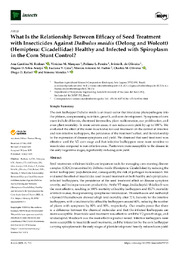What is the relationship between efficacy of seed treatment with insecticides against Dalbulus maidis (Delong and Wolcott) (Hemiptera: Cicadellidae) healthy and infected with spiroplasm in the corn stunt control?
What is the relationship between efficacy of seed treatment with insecticides against Dalbulus maidis (Delong and Wolcott) (Hemiptera: Cicadellidae) healthy and infected with spiroplasm in the corn stunt control?
Autoria: REDOAN, A. C. M.; MARQUES, V. M.; PEREIRA, P. S.; OLIVEIRA, I. R. de; SILVA, D. D. da; COTA, L. V.; FADINI, M. A. M.; OLIVEIRA, C. M. de; RAFAEL, D. D.; MENDES, S. M.
Resumo: Seed treatments with insecticides are important tools for managing corn stunting disease complex (CSDC) transmitted by Dalbulus maidis (Hemiptera: Cicadellidae) by reducing the initial leafhoppers’ population and, consequently, the risk of pathogen transmission. We evaluated the effect of insecticides used in seed treatment on both healthy and spiroplasmainfected leafhoppers, the persistence of the seed treatment effect on disease symptom severity, and its impact on corn productivity. At the V2 stage, imidacloprid/thiodicarb was the most effective, resulting in 100% mortality of healthy leafhoppers and 85.7% mortality of infective ones, thus preventing spiroplasma transmission. Thiamethoxam and methomyl + fipronil/thiamethoxam showed a high total mortality after 72 h, but only for the infective leafhoppers, with a total mortality of healthy leafhoppers around 40%, reducing the number of plants with symptoms by 80% and 90%, respectively. Our results prove that there is a difference between the chemical molecules and that the infected leafhoppers are more susceptible. Insecticide seed treatment was effective until the V2 growth stage, and imidacloprid/thiodicarb was the most effective product tested. Infective leafhoppers were more susceptible to insecticide seed treatments, and the infestation by the corn leafhopper carrying spiroplasma in the early stages of plant development heavily reduced corn yield.
Ano de publicação: 2025
Tipo de publicação: Artigo de periódico
Unidade: Embrapa Milho e Sorgo
Palavras-chave: Bactéria, Cigarrinha, Controle Químico, Manejo integrado, Milho, Zea Mays
Observações
1 - Por padrão são exibidas publicações dos últimos 20 anos. Para encontrar publicações mais antigas, configure o filtro ano de publicação, colocando o ano a partir do qual você deseja encontrar publicações. O filtro está na coluna da esquerda na busca acima.
2 - Para ler algumas publicações da Embrapa (apenas as que estão em formato ePub), é necessário ter, no celular ou computador, um desses softwares gratuitos. Sistemas Android: Google Play Livros; IOS: iBooks; Windows e Linux: software Calibre.
Acesse outras publicações
Acesse a Base de Dados da Pesquisa Agropecuária (BDPA) para consultar o acervo completo das bibliotecas da Embrapa.

